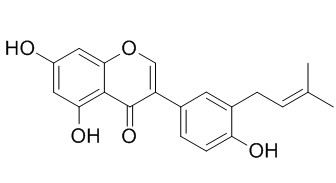Isowighteone
Isowighteone, a compound that is not naturally produced in this species, accumulated by medicago truncatula hairy roots expressing LaPT1, indicates a strategy for metabolic engineering of novel antimicrobial compounds in legumes; it may have antimicrobial activity against fungal pathogens of plants.
Inquire / Order:
manager@chemfaces.com
Technical Inquiries:
service@chemfaces.com
Tel:
+86-27-84237783
Fax:
+86-27-84254680
Address:
1 Building, No. 83, CheCheng Rd., Wuhan Economic and Technological Development Zone, Wuhan, Hubei 430056, PRC
Providing storage is as stated on the product vial and the vial is kept tightly sealed, the product can be stored for up to
24 months(2-8C).
Wherever possible, you should prepare and use solutions on the same day. However, if you need to make up stock solutions in advance, we recommend that you store the solution as aliquots in tightly sealed vials at -20C. Generally, these will be useable for up to two weeks. Before use, and prior to opening the vial we recommend that you allow your product to equilibrate to room temperature for at least 1 hour.
Need more advice on solubility, usage and handling? Please email to: service@chemfaces.com
The packaging of the product may have turned upside down during transportation, resulting in the natural compounds adhering to the neck or cap of the vial. take the vial out of its packaging and gently shake to let the compounds fall to the bottom of the vial. for liquid products, centrifuge at 200-500 RPM to gather the liquid at the bottom of the vial. try to avoid loss or contamination during handling.
J Sep Sci.2018, 41(11):2488-2497
Heliyon.2024, 10(12):e31722.
Medicinal Chemistry Research 2021, 30:1117-1124.
Industrial Crops and Products2021, 163:113313.
Front Plant Sci.2024, 15:1458916.
Lab Chip.2018, 18(6):971-978
J Exp Bot.2016, 67(12):3777-88
Front Immunol. 2020, 11:62.
Asian Journal of Chemistry2014, 26(22):7811-7816
Pharmacognosy Journal2019, 11,6:1235-1241
Related and Featured Products
Plant Physiol. 2012 May;159(1):70-80.
Characterization of an isoflavonoid-specific prenyltransferase from Lupinus albus.[Pubmed:
22430842]
Prenylated flavonoids and isoflavonoids possess antimicrobial activity against fungal pathogens of plants. However, only a few plant flavonoid and isoflavonoid prenyltransferase genes have been identified to date.
METHODS AND RESULTS:
In this study, an isoflavonoid prenyltransferase gene, designated as LaPT1, was identified from white lupin (Lupinus albus). The deduced protein sequence of LaPT1 shared high homologies with known flavonoid and isoflavonoid prenyltransferases. The LaPT1 gene was mainly expressed in roots, a major site for constitutive accumulation of prenylated isoflavones in white lupin. LaPT1 is predicted to be a membrane-bound protein with nine transmembrane regions and conserved functional domains similar to other flavonoid and isoflavonoid prenyltransferases; it has a predicted chloroplast transit peptide and is plastid localized. A microsomal fraction containing recombinant LaPT1 prenylated the isoflavone genistein at the B-ring 3' position to produce Isowighteone. The enzyme is also active with 2'-hydroxygenistein but has no activity with other flavonoid substrates. The apparent K(m) of recombinant LaPT1 for the dimethylallyl diphosphate prenyl donor is in a similar range to that of other flavonoid prenyltransferases, but the apparent catalytic efficiency with genistein is considerably higher. Removal of the transit peptide increased the apparent overall activity but also increased the K(m).
CONCLUSIONS:
Medicago truncatula hairy roots expressing LaPT1 accumulated Isowighteone, a compound that is not naturally produced in this species, indicating a strategy for metabolic engineering of novel antimicrobial compounds in legumes.



